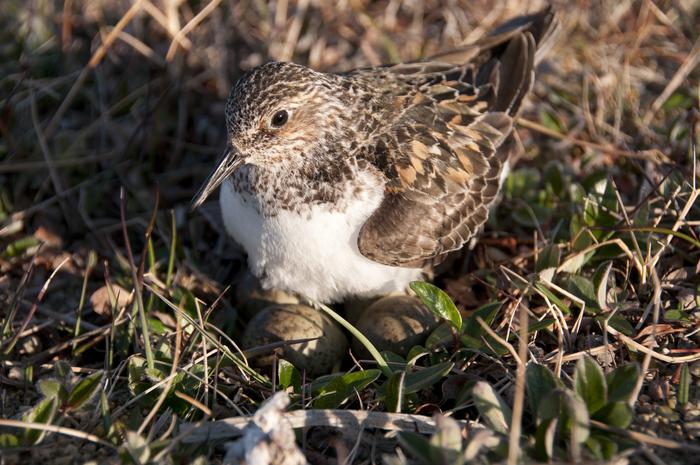About 15 years ago, researchers reported that the timing of spring in high-Arctic Greenland had advanced at some of the fastest rates of change ever seen anywhere in the world. But, according to new evidence reported in the journal Current Biology on July 26, that earlier pattern has since been completely erased. Instead of coming earlier and earlier, it seems the timing of Arctic spring is now driven by tremendous climate variability with drastic differences from one year to the next.

Credit: Jeroen Reneerkens
About 15 years ago, researchers reported that the timing of spring in high-Arctic Greenland had advanced at some of the fastest rates of change ever seen anywhere in the world. But, according to new evidence reported in the journal Current Biology on July 26, that earlier pattern has since been completely erased. Instead of coming earlier and earlier, it seems the timing of Arctic spring is now driven by tremendous climate variability with drastic differences from one year to the next.
“As scientists we are obliged to revisit previous work to see whether the knowledge obtained at that time still holds,” says Niels Martin Schmidt (@NielsMSchmidt) of Aarhus University in Denmark. “We looked at previously reported extreme rates of phenological advancements in the Arctic and found that directional advancement is no longer the prevailing pattern. Actually, the previously observed trend has disappeared completely and has been replaced by extreme year-to-year variation in the onset of spring.”
Global changes in climate are expected to take place faster in the Arctic than in places at lower latitudes. To follow those trends, researchers at Zackenberg in Northeast Greenland launched an ecosystem-wide monitoring program in 1996. Among a suite of ecosystem variables, the program also tracks the timing of spring based on flowering plants, arthropod emergence, and bird nesting.
When the first 10 years of data were analyzed for 1996–2005, the findings showed a clear pattern of advancement across plants and animals included in the study. For instance, they saw some arthropods emerging up to 4 weeks earlier. In the new study, Schmidt and his colleagues wanted to see how these trends look now that they have 15 additional years of data available.
After analyzing the phenological data from 1996–2020, they report little evidence of directional change in the timing of events even as climate change continues. The researchers attribute this shift to a high degree of climate variability from year to year.
“That the extreme rates of phenological advancement we reported back in 2007 would not have continued unabated was not surprising to us,” Schmidt said. “However, that we see such a consistent shift from directional to extreme variability across so many different organisms and that the entire ecosystem now seems driven by variation in climatic conditions, was surprising.”
Schmidt says that the previous pattern showed steadily rising temperatures and declining snow cover. Now, what they see is a lot messier. Temperature increases have stalled while snow cover fluctuates dramatically from year to year.
“Some years have almost no snow in spring, whereas others have snow on the ground way into the summer season,” he says. “This leaves us with a generally warmer but much more unpredictable spring climate—and this is where the second contributor to the observed phenological shift kicks in. Some species appear unable to take advantage of the warmer conditions in spring and appear to have reached the limits of their phenological plasticity.”
Plants and animals have some flexibility that allows them to track the climatic conditions in their environment, he explains. Arctic species in particular appear to have a high degree of phenological plasticity. Even so, the new evidence suggests that some species are already being pushed about as far as they can go. For instance, they don’t flower as early in warm summers as one might expect. As the Arctic continues to warm, the researchers predict that a growing number of species will become “increasingly out of sync with the climatic conditions.”
The new findings highlight the unfortunate reality that the lack in directional change does not mean that the climate is stable. In this case, quite the opposite is true. The climate pattern shows wide variation that may be pushing organisms and whole ecosystems to their limits. The researchers will continue to explore species-specific responses to the shifting climate pattern and its effects on essential interactions, such as pollination. They hope to learn how the responses of an individual species will cascade through the community. The findings are a reminder of the importance of long-term study.
“These insights can only be obtained because of sustained, ecosystem-wide, long-term monitoring with rigorous field sampling across more than 25 years at a very remote corner of the world,” Schmidt says. “Continued long-term monitoring is key to understand ecosystems and to detect changes in dynamics.”
###
This work was supported by the Danish Environmental Protection Agency, the Kvantum Institute at the University of Oulu, Academy of Finland, the Jane and Aatos Erkko Foundation, and the European Research Council.
Current Biology, Schmidt et al. “Little directional change in the timing of Arctic spring phenology over the past 25 years” https://www.cell.com/current-biology/fulltext/S0960-9822(23)00823-0
Current Biology (@CurrentBiology), published by Cell Press, is a bimonthly journal that features papers across all areas of biology. Current Biology strives to foster communication across fields of biology, both by publishing important findings of general interest and through highly accessible front matter for non-specialists. Visit: http://www.cell.com/current-biology. To receive Cell Press media alerts, contact [email protected].
Journal
Current Biology
DOI
10.1016/j.cub.2023.06.038
Method of Research
Observational study
Subject of Research
Not applicable
Article Title
Little directional change in the timing of Arctic spring phenology over the past twenty-five years
Article Publication Date
26-Jul-2023




